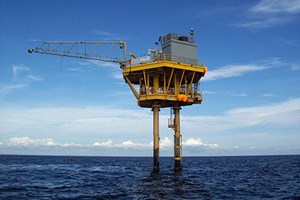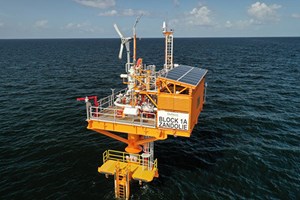Offshore technology: Platform design: Is the next generation of offshore platforms changing offshore energy?
The unprecedented challenges faced in the last decade and today's rapidly evolving landscape have brought the offshore energy industry to a pivotal juncture. The sector is balancing the imminent need for energy security while spearheading transition targets. Societies are demanding more secure and sustainable energy with greater urgency than ever before; eyes are on the industry to deliver.
Driven by this, the offshore landscape is undergoing rapid transformation. No longer dominated solely by oil and gas, there is now an emerging mix of offshore wind and carbon capture use and storage (CCUS), with sights set on green hydrogen production. If someone from 2003 were transported to the present, they would hardly recognize the offshore landscape of 2023. However, they could identify the common technological thread that binds all these applications together. And it's safe to say that by 2043, the changes will be even more notable, as the pace of transformation continues to accelerate.
To meet this changing environment, offshore tools, technologies and engineering approaches have moved at a similar pace. As one of the most familiar pieces of offshore infrastructure, it may not be immediately obvious how offshore platforms have been at the forefront of this transformation, but there has been a revolution in the way platforms are planned, engineered and operated in recent years.
THE OFFSHORE ECONOMY OF THE PRESENT
It used to be that oil and gas was the only offshore game in town. Today, vast swathes of coastal shelf are dotted with wind turbines. Tomorrow, we can add the likes of offshore green hydrogen production, CCS reinjection projects and yes, the next generation of oil and gas infrastructure, too. It may not be too long after that we see wind and tidal renewable resources gain ground—or even the advent of subsea mining projects—as we scramble to meet the growing materials needs of the energy transition.
In other words, an entire offshore economy is booming, and each project or technology will need a base to stand on. Some of it may be floating infrastructure, but there will still be a huge demand for fixed-base platforms. The topsides of these structures, however, will be far more heterogenous than those of today—and in fact, may change over time, as needs evolve. The question is this: how do we design with flexibility in mind?
FLEXIBILITY FOR THE FUTURE
Broadly speaking, we can imagine two approaches to designing flexibility. One is to default to “bigger is better.” The other is to focus on modularization, allowing offshore developers to “mix and match” the right topsides with the right subsea structures.
In favor of a maximal approach: a sturdy platform with a spacious topside is a blank canvas for offshore infrastructure. Did you drill six wells with processing capacity and want to add six more via tie-back later? No problem. Do you want to repurpose it for CCS reinjection? There are no space constraints to speak of. Have you maxed out electrolyser capacity but have access to enough electricity to support more? Go ahead and install new units.
Having spare offshore real estate is one way to ensure future flexibility, but it is a hugely expensive one. A more cost-effective approach is to design for what is needed now—to focus on the must-haves and not the “nice-to-haves.”
While some projects—due to topside requirements or soil conditions—may still require full jacketed substructures, many can be adequately served by simpler and lighter substructure solutions, which can not only support improved project outcomes but also help to cut costs.
Industry leaders recognize that smaller, modular and customized platforms—such as our Sea Swift platforms (Fig. 1)—are the way forward. When it comes to offshore engineering, less truly is more. By opting for platforms that are tailored to specific needs, we can achieve numerous benefits: reduced carbon emissions; lower fabrication and transportation costs; lower operational expenses; and quicker production times. Where once we talked of time to first oil, now we can add time to first hydrogen, electricity or CO2 reinjection.
Combining new technologies with the modular mindset described above can also open a range of new applications. Platforms can be decked out to function as substations for offshore wind developments, tailored to the size and scale of each project, transforming and transmitting power generated to onshore power grids. Alternatively, electrolysis technology can be integrated into platforms to efficiently produce green hydrogen, providing flexibility to operators.
This flexibility can benefit CO2 injection projects too. Whether utilizing an existing platform or building a new structure, platform topsides can be modified easily to include the required components, such as CO2 compressors and storage infrastructure—designed to withstand the specific properties and behavior of CO2, which are crucial to optimizing injection operations.
THE NEXT GEN OF INTELLIGENT PLATFORMS
The impact of offshore platforms on the industry goes beyond size and modularity. Operators, who are genuinely committed to minimizing their carbon footprint, now seek solutions that support this goal without compromising successful project execution.
One way to do so is to change how topsides are powered. Platforms are agnostic as to what gets placed upon them, and today, there is no reason why diesel gensets can’t be replaced or augmented by solar panels or a wind turbine. This has an obvious environmental benefit, in that every kWh of diesel generation displaced by renewables drives a carbon saving, but we can add to that the reduced emissions associated with transporting that fuel to the platform at regular intervals. This also ensures reduced rig time, as renewably-powered platforms can be comfortably operated remotely most of the time—therefore reducing the risk to personnel, too.
We recently applied this approach in offshore Angola, where we designed a 100% autonomously powered platform for a major operator. The platform was required to be completely autonomous from a power generation and storage perspective, due to its distance from the host platform, which negated the ability to run a subsea cable. There was also a desire from the client to reduce the safety risks associated with personnel travelling offshore for maintenance visits.
To solve this, a power system using PV panels, with battery storage for back-up power, was selected, Fig. 2. We calculated the optimal number of panels that would be needed for 100% autonomous power. This was combined with power-saving measures, such as the use of LED lighting, and resulted in a platform that was not only more efficient and environmentally friendly but was also tailored to the specific needs of the operator.
Put simply, intelligent platforms are trailblazers in the energy transition, by making possible the infrastructure required not only for today but also for the energy demands of tomorrow. It’s about rethinking and redesigning legacy assets that the sector has used for decades, to make a more sustainable offshore economy a reality. Intelligent engineering and design can unlock the project economics of innovative new offshore energies and deliver emissions savings to projects new and old, alike. If we are to meet our immediate- and intermediate-term energy needs, we need fast and flexible deployment, posthaste.
- Regional report: Guyana-Suriname: Rapid expansion of production continues (July 2024)
- Annular safety valves advance flexibility, reliability and safety in completion operations (July 2024)
- Well decommissioning: Simple solutions to complex problems (June 2024)
- Rethinking sand management for optimized production (June 2024)
- Can an offshore drilling rig run on green methanol? (May 2024)
- Addressing the new global challenges of P&As (December 2021)




